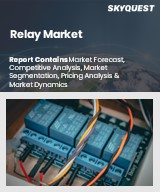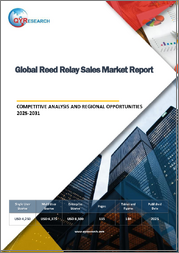
|
시장보고서
상품코드
1825299
세계의 전기기계식 릴레이 시장 : 예측(2025-2030년)Global Electromechanical Relay Market - Forecasts from 2025 to 2030 |
||||||
전기기계식 릴레이 시장은 CAGR 3.34%로, 2025년 76억 3,100만 달러에서 2030년에는 89억 9,300만 달러로 성장할 것으로 예측됩니다.
전기기계식 릴레이는 최소한의 전력 입력으로 고출력 전기기기를 제어하는 필수적인 스위칭 장치로 교류와 직류 시스템 모두에서 효과적으로 작동합니다. 이 장치들은 통전 시 자력을 발생시켜 내부 스위칭 메커니즘을 제어함으로써 다양한 산업 및 민생 용도에서 신뢰할 수 있는 전기 회로 관리를 가능하게 합니다.
기술 기반 및 동작 특성
전기기계식 릴레이는 작동 수명 연장, 전력 소비 감소, 쉬운 유지 보수 요구 사항 등 우수한 성능 특성을 보여줍니다. 이 기술은 온-오프 동작, 리미트 제어, 로직 동작을 포함한 여러 제어 기능을 지원하며, 전기 시스템 관리의 기본 구성 요소로 자리매김하고 있습니다.
활용 분야는 TV 및 디지털 셋톱박스의 전원 스위칭, 공장 자동화 시스템, HVAC 장비의 온도 제어, 모터 제어 용도 등 다양한 분야에 적용되고 있습니다. 이러한 다용도성으로 인해 전기기계식 릴레이는 주거, 상업 및 산업 환경에서 중요한 인프라 구성 요소로 자리매김하고 있습니다.
이 기술의 신뢰성은 오랜 기간 동안 안정적인 성능을 유지하면서 가혹한 작동 조건을 견딜 수 있는 견고한 기계 구조에서 비롯됩니다. 비용 효율성과 검증된 신뢰성을 겸비한 전기기계식 릴레이는 고도의 전자 제어가 필요하지 않고 신뢰할 수 있는 스위칭 성능을 필요로 하는 응용 분야에 특히 매력적입니다.
시장 세분화 및 응용 분야
전기기계식 계전기 시장에는 범용 계전기, 전력 계전기, 접촉기, 시간 지연 계전기, 특정 용도에 맞게 설계된 특수 제품 등 다양한 제품 카테고리가 있습니다. 이 세분화는 다양한 산업 및 소비자용도의 다양한 성능 요구 사항을 반영합니다.
응용 분야에는 공장 자동화, 온도 제어 시스템, 모터 제어 및 다양한 특수 구현이 포함됩니다. 최종 사용자 부문에는 항공우주 및 방위, 통신 및 기술, HVAC 시스템, 자동차 용도, 가전제품, 기타 다양한 산업 분야가 포함됩니다.
세계 수요 동향과 지역 산업 발전 추세를 반영하여 북미, 남미, 유럽, 중동 및 아프리카, 아시아태평양 각 지역에 분포되어 있습니다.
주요 성장 요인
에너지 효율 및 비용 관리
세계적으로 에너지 비용이 상승함에 따라 전력 소비를 최적화하고 시스템 효율을 높이는 첨단 전기기계식 릴레이에 대한 수요가 증가하고 있습니다. 기업들은 안정적인 운영 성능을 유지하면서 에너지 낭비를 최소화하는 스위칭 솔루션을 찾고 있으며, 이는 효율적인 릴레이 기술에 대한 지속적인 수요를 창출하고 있습니다.
낮은 초기 비용, 작동 수명 연장, 전력 소비 감소, 유지보수 간소화 등의 조합으로 다양한 용도에 매력적인 가치를 제안할 수 있습니다. 이러한 경제적 이점으로 인해 전기기계식 계전기는 비용에 민감한 용도에서 다른 스위칭 기술에 비해 유리한 위치를 점하고 있습니다.
재생에너지 통합
재생에너지 프로젝트가 확대됨에 따라 고급 전력 관리 요구 사항을 관리할 수 있는 대용량 전기기계식 릴레이에 대한 수요가 증가하고 있습니다. 재생 에너지 시스템에는 시스템의 안정성과 안전 기준을 유지하면서 변동하는 전력 조건에 대응할 수 있는 신뢰할 수 있는 스위칭 구성 요소가 필요합니다.
공장 자동화 및 산업 기술
산업 시설에서 신뢰할 수 있는 스위칭 솔루션을 필요로 하는 고도의 자동화 기술을 도입함에 따라 공장 자동화 분야의 발전이 시장 성장을 크게 촉진하고 있습니다. 다양한 산업분야에서 자동화 기술이 확산됨에 따라 전기기계식 계전기의 응용 기회가 확대되고 있습니다.
자동차 및 가전제품 확대
과부하 및 고장 상태로부터 회로를 보호하기 위한 자동차용 퓨즈박스의 활용이 확대되면서 시장 확대의 원동력이 되고 있습니다. 제조업체들이 신뢰할 수 있는 스위칭 기능을 필요로 하는 다양한 전자기기에 릴레이 기술을 통합함에 따라, 민수용 전자기기 용도는 계속 확대되고 있습니다.
시장 성장 억제요인과 경쟁 압력
솔리드 스테이트 릴레이의 경쟁사
반도체 제조 및 제조 기술의 발전으로 인해 솔리드 스테이트 릴레이가 대체품으로 사용할 수있게되어 큰 경쟁 압력이되고 있습니다. 솔리드 스테이트 대체품은 빠른 스위칭 속도, 전자기 간섭 감소, 기계적 마모 부품 제거 등의 장점이 있습니다.
반도체 기술의 향상으로 솔리드 스테이트 릴레이의 성능은 지속적으로 향상되고 있으며, 동시에 비용도 절감되어 기존의 전기기계식 릴레이 기술에 대한 지속적인 경쟁 과제가 발생하고 있습니다. 시장에서 성공하기 위해서는 기계식 스위칭 솔루션의 고유한 장점을 강조하는 한편, 전기기계식 릴레이가 성능 및 비용 우위를 유지하고 있는 응용 분야를 다루어야 합니다.
전략적 시장 전망
전기기계식 계전기 시장은 자동화 요구사항의 확대와 반도체 대체 기술의 발전으로 인해 상쇄되는 경쟁 환경 속에서 운영되고 있습니다. 공장 자동화, 재생 에너지, 산업 기술 부문의 새로운 용도 요구 사항을 충족시키면서 비용 효율성, 신뢰성, 편의성 등 기계식 릴레이의 장점을 활용하여 성공할 수 있어야 합니다.
본 보고서의 주요 장점
- 통찰력 있는 분석 : 고객 부문, 정부 정책 및 사회경제적 요인, 소비자 선호도, 산업별, 기타 하위 부문에 초점을 맞추고 주요 지역뿐만 아니라 신흥 지역까지 포괄하는 상세한 시장 인사이트를 얻을 수 있습니다.
- 경쟁 구도: 세계 주요 기업들이 채택하고 있는 전략적 전략을 이해하고, 적절한 전략을 통한 시장 침투 가능성을 파악할 수 있습니다.
- 시장 성장 촉진요인과 미래 동향 : 역동적인 요인과 매우 중요한 시장 동향, 그리고 이들이 향후 시장 발전을 어떻게 형성할 것인지에 대해 알아봅니다.
- 실행 가능한 제안: 역동적인 환경 속에서 새로운 비즈니스 스트림과 수익을 발굴하기 위한 전략적 의사결정에 통찰력을 활용합니다.
- 다양한 사용자에 대응: 스타트업, 연구기관, 컨설턴트, 중소기업, 대기업에 유익하고 비용 효율적임.
어떤 용도로 사용되는가?
산업 및 시장 인사이트, 사업 기회 평가, 제품 수요 예측, 시장 진출 전략, 지리적 확장, 설비 투자 결정, 규제 프레임워크와 영향, 신제품 개발, 경쟁의 영향
분석 범위
- 과거 데이터(2022-2024년) 및 예측 데이터(2025-2030년)
- 성장 기회, 과제, 공급망 전망, 규제 프레임워크, 고객 행동, 트렌드 분석
- 경쟁사 포지셔닝, 전략 및 시장 점유율 분석
- 매출 성장률 및 예측 분석 : 부문별/지역별(국가별)
- 기업 프로파일링(전략, 제품, 재무정보, 주요 동향 등)
목차
제1장 주요 요약
제2장 시장 현황
- 시장 개요
- 시장의 정의
- 분석 범위
- 시장 구분
제3장 비즈니스 상황
- 시장 성장 촉진요인
- 시장 성장 억제요인
- 시장 기회
- Porter의 Five Forces 분석
- 업계 밸류체인 분석
- 정책 및 규제
- 전략적 제안
제4장 기술 전망
제5장 전기기계식 릴레이 시장 : 유형별
- 서론
- 범용 릴레이
- 파워 릴레이
- 콘택터
- 시간 지연 릴레이
- 리드 릴레이
- 랏팅리레이
- 기타
제6장 전기기계식 릴레이 시장 : 용도별
- 서론
- 공장 자동화
- 모터 제어
- 온도 컨트롤러
- 조명 제어
- 배전·보호
- 기타
제7장 전기기계식 릴레이 시장 : 최종사용자 산업별
- 서론
- 항공우주 및 방위
- 통신·테크놀러지
- 공조 설비
- 자동차
- 가전
- 산업 및 제조업
- 전력 및 에너지
- 기타
제8장 전기기계식 릴레이 시장 : 지역별
- 서론
- 북미
- 유형별
- 용도별
- 최종사용자 산업별
- 국가별
- 미국
- 캐나다
- 멕시코
- 남미
- 유형별
- 용도별
- 최종사용자 산업별
- 국가별
- 브라질
- 아르헨티나
- 기타
- 유럽
- 유형별
- 용도별
- 최종사용자 산업별
- 국가별
- 영국
- 독일
- 프랑스
- 스페인
- 기타
- 중동 및 아프리카
- 유형별
- 용도별
- 최종사용자 산업별
- 국가별
- 사우디아라비아
- 아랍에미리트(UAE)
- 기타
- 아시아태평양
- 유형별
- 용도별
- 최종사용자 산업별
- 국가별
- 중국
- 일본
- 인도
- 한국
- 대만
- 기타
제9장 경쟁 환경과 분석
- 주요 기업과 전략 분석
- 시장 점유율 분석
- 인수합병(M&A), 합의 및 협업
- 경쟁 대시보드
제10장 기업 개요
- OMRON Corporation
- Schneider Electric
- ABB Ltd.
- Eaton Corporation
- TE Connectivity
- Panasonic Electric Works Co., Ltd.
- Fujitsu Components Ltd.
- Rockwell Automation, Inc.
- Mitsubishi Electric Corporation
제11장 부록
- 통화
- 전제조건
- 기준연도와 예측연도 타임라인
- 이해관계자의 주요 이점
- 분석 방법
- 약어
The Electromechanical Relay Market is expected to grow from USD 7.631 billion in 2025 to USD 8.993 billion in 2030, at a CAGR of 3.34%.
Electromechanical relays represent essential switching devices that control high-power electrical equipment through minimal power input, operating effectively with both alternating current and direct current systems. These devices generate magnetic force when energized, controlling internal switching mechanisms that enable reliable electrical circuit management across diverse industrial and consumer applications.
Technology Foundation and Operational Characteristics
Electromechanical relays demonstrate superior performance characteristics including extended operational life, reduced power consumption, and straightforward maintenance requirements. The technology supports multiple control functions encompassing on-off operations, limit control, and logic operations, establishing these devices as fundamental components in electrical system management.
Applications span numerous sectors including power supply switching in televisions and digital set-top boxes, factory automation systems, temperature control in HVAC equipment, and motor control applications. This versatility positions electromechanical relays as critical infrastructure components across residential, commercial, and industrial environments.
The technology's reliability stems from robust mechanical construction that withstands demanding operational conditions while maintaining consistent performance over extended periods. Cost-effectiveness combined with proven reliability makes electromechanical relays particularly attractive for applications requiring dependable switching performance without sophisticated electronic controls.
Market Segmentation and Application Areas
The global electromechanical relay market encompasses diverse product categories including general purpose relays, power relays, contactors, time-delay relays, and specialized variants designed for specific applications. This segmentation reflects varied performance requirements across different industrial and consumer applications.
Application categorization includes factory automation, temperature control systems, motor controls, and numerous specialized implementations. End-user segments span aerospace and defense, communication and technology, HVAC systems, automotive applications, consumer electronics, and various other industrial sectors.
Geographic distribution covers North America, South America, Europe, Middle East and Africa, and Asia Pacific regions, reflecting global demand patterns and regional industrial development trends.
Primary Growth Drivers
Energy Efficiency and Cost Management
Rising global energy costs drive increasing demand for advanced electromechanical relays that optimize power consumption and enhance system efficiency. Organizations seek switching solutions that minimize energy waste while maintaining reliable operational performance, creating sustained demand for efficient relay technologies.
The combination of low initial costs, extended operational life, reduced power consumption, and simplified maintenance creates compelling value propositions for diverse applications. These economic advantages position electromechanical relays favorably against alternative switching technologies in cost-sensitive applications.
Renewable Energy Integration
Expanding renewable energy projects fuel demand for high-capacity electromechanical relays capable of managing sophisticated power management requirements. Renewable energy systems require reliable switching components that handle variable power conditions while maintaining system stability and safety standards.
Factory Automation and Industrial Technology
Developments in factory automation sectors significantly drive market growth as industrial facilities implement advanced automation technologies requiring reliable switching solutions. The increasing penetration of automation technologies across various industries creates expanding opportunities for electromechanical relay applications.
Automotive and Consumer Electronics Expansion
Growing utilization in automotive fuse boxes for circuit protection against overload and fault conditions drives market expansion. Consumer electronics applications continue expanding as manufacturers integrate relay technologies into diverse electronic appliances requiring reliable switching functionality.
Market Constraints and Competitive Pressures
Solid-State Relay Competition
The availability of solid-state relays as substitutes presents significant competitive pressure due to advancements in semiconductor fabrication and manufacturing technologies. Solid-state alternatives offer advantages including faster switching speeds, reduced electromagnetic interference, and elimination of mechanical wear components.
Semiconductor technology improvements continue enhancing solid-state relay capabilities while reducing costs, creating ongoing competitive challenges for traditional electromechanical relay technologies. Market success requires emphasizing unique advantages of mechanical switching solutions while addressing application areas where electromechanical relays maintain performance or cost advantages.
Strategic Market Outlook
The electromechanical relay market operates within a competitive environment characterized by expanding automation requirements offset by advancing semiconductor alternatives. Success requires leveraging mechanical relay advantages including cost-effectiveness, reliability, and simplicity while addressing emerging application requirements in factory automation, renewable energy, and industrial technology sectors.
Key Benefits of this Report:
- Insightful Analysis: Gain detailed market insights covering major as well as emerging geographical regions, focusing on customer segments, government policies and socio-economic factors, consumer preferences, industry verticals, and other sub-segments.
- Competitive Landscape: Understand the strategic maneuvers employed by key players globally to understand possible market penetration with the correct strategy.
- Market Drivers & Future Trends: Explore the dynamic factors and pivotal market trends and how they will shape future market developments.
- Actionable Recommendations: Utilize the insights to exercise strategic decisions to uncover new business streams and revenues in a dynamic environment.
- Caters to a Wide Audience: Beneficial and cost-effective for startups, research institutions, consultants, SMEs, and large enterprises.
What do businesses use our reports for?
Industry and Market Insights, Opportunity Assessment, Product Demand Forecasting, Market Entry Strategy, Geographical Expansion, Capital Investment Decisions, Regulatory Framework & Implications, New Product Development, Competitive Intelligence
Report Coverage:
- Historical data from 2022 to 2024 & forecast data from 2025 to 2030
- Growth Opportunities, Challenges, Supply Chain Outlook, Regulatory Framework, and Trend Analysis
- Competitive Positioning, Strategies, and Market Share Analysis
- Revenue Growth and Forecast Assessment of segments and regions including countries
- Company Profiling (Strategies, Products, Financial Information, and Key Developments among others.
Electromechanical Relay Market Segmentation:
By Type
- General Purpose Relays
- Power Relays
- Contactors
- Time-Delay Relays
- Reed Relays
- Latching Relays
- Others
By Application
- Factory Automation
- Motor Controls
- Temperature Controllers
- Lighting Controls
- Power Distribution & Protection
- Others
By End-User Industry
- Aerospace and Defense
- Communication and Technology
- HVAC
- Automotive
- Consumer Electronics
- Industrial Manufacturing
- Power & Energy
- Others
By Geography
- North America
- USA
- Canada
- Mexico
- South America
- Brazil
- Argentina
- Others
- Europe
- United Kingdom
- Germany
- France
- Spain
- Others
- Middle East and Africa
- Saudi Arabia
- UAE
- Others
- Asia Pacific
- China
- Japan
- India
- South Korea
- Taiwan
- Others
TABLE OF CONTENTS
1. EXECUTIVE SUMMARY
2. MARKET SNAPSHOT
- 2.1. Market Overview
- 2.2. Market Definition
- 2.3. Scope of the Study
- 2.4. Market Segmentation
3. BUSINESS LANDSCAPE
- 3.1. Market Drivers
- 3.2. Market Restraints
- 3.3. Market Opportunities
- 3.4. Porter's Five Forces Analysis
- 3.5. Industry Value Chain Analysis
- 3.6. Policies and Regulations
- 3.7. Strategic Recommendations
4. TECHNOLOGICAL OUTLOOK
5. ELECTROMECHANICAL RELAY MARKET BY TYPE
- 5.1. Introduction
- 5.2. General Purpose Relays
- 5.3. Power Relays
- 5.4. Contactors
- 5.5. Time-Delay Relays
- 5.6. Reed Relays
- 5.7. Latching Relays
- 5.8. Others
6. ELECTROMECHANICAL RELAY MARKET BY APPLICATION
- 6.1. Introduction
- 6.2. Factory Automation
- 6.3. Motor Controls
- 6.4. Temperature Controllers
- 6.5. Lighting Controls
- 6.6. Power Distribution & Protection
- 6.7. Others
7. ELECTROMECHANICAL RELAY MARKET BY END-USER INDUSTRY
- 7.1. Introduction
- 7.2. Aerospace and Defense
- 7.3. Communication and Technology
- 7.4. HVAC
- 7.5. Automotive
- 7.6. Consumer Electronics
- 7.7. Industrial Manufacturing
- 7.8. Power & Energy
- 7.9. Others
8. ELECTROMECHANICAL RELAY MARKET BY GEOGRAPHY
- 8.1. Introduction
- 8.2. North America
- 8.2.1. By Type
- 8.2.2. By Application
- 8.2.3. By End-User Industry
- 8.2.4. By Country
- 8.2.4.1. USA
- 8.2.4.2. Canada
- 8.2.4.3. Mexico
- 8.3. South America
- 8.3.1. By Type
- 8.3.2. By Application
- 8.3.3. By End-User Industry
- 8.3.4. By Country
- 8.3.4.1. Brazil
- 8.3.4.2. Argentina
- 8.3.4.3. Others
- 8.4. Europe
- 8.4.1. By Type
- 8.4.2. By Application
- 8.4.3. By End-User Industry
- 8.4.4. By Country
- 8.4.4.1. United Kingdom
- 8.4.4.2. Germany
- 8.4.4.3. France
- 8.4.4.4. Spain
- 8.4.4.5. Others
- 8.5. Middle East and Africa
- 8.5.1. By Type
- 8.5.2. By Application
- 8.5.3. By End-User Industry
- 8.5.4. By Country
- 8.5.4.1. Saudi Arabia
- 8.5.4.2. UAE
- 8.5.4.3. Others
- 8.6. Asia Pacific
- 8.6.1. By Type
- 8.6.2. By Application
- 8.6.3. By End-User Industry
- 8.6.4. By Country
- 8.6.4.1. China
- 8.6.4.2. Japan
- 8.6.4.3. India
- 8.6.4.4. South Korea
- 8.6.4.5. Taiwan
- 8.6.4.6. Others
9. COMPETITIVE ENVIRONMENT AND ANALYSIS
- 9.1. Major Players and Strategy Analysis
- 9.2. Market Share Analysis
- 9.3. Mergers, Acquisitions, Agreements, and Collaborations
- 9.4. Competitive Dashboard
10. COMPANY PROFILES
- 10.1. OMRON Corporation
- 10.2. Schneider Electric
- 10.3. ABB Ltd.
- 10.4. Eaton Corporation
- 10.5. TE Connectivity
- 10.6. Panasonic Electric Works Co., Ltd.
- 10.7. Fujitsu Components Ltd.
- 10.8. Rockwell Automation, Inc.
- 10.9. Mitsubishi Electric Corporation
11. APPENDIX
- 11.1. Currency
- 11.2. Assumptions
- 11.3. Base and Forecast Years Timeline
- 11.4. Key benefits for the stakeholders
- 11.5. Research Methodology
- 11.6. Abbreviations



















